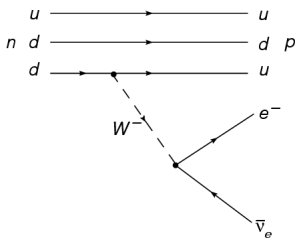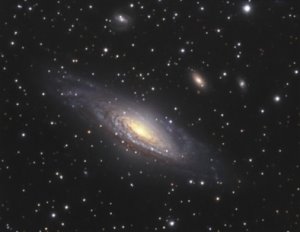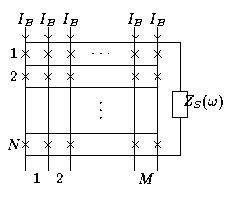|
|
|
|
|
|
|

I was working at Friedrich Schiller University, Jena, Germany, from 1978 to 1997. During this time, I was mainly performing research in the following three fields:
Gauge Field TheoriesAfter completing my studies I decided to write my diploma thesis in the Department of Relativistic Physics at Jena University. The thesis dealt with symmetries of electromagnetic fields. As a result, I got a complete classification of highly symmetric (4-6 Killing vectors = independent symmetries) electromagnetic fields.

This was just the time when non-Abelian gauge fields became very popular with the theoretical and later experimental success of the Salam-Weinberg theory of electro-weak interactions. Although I'm no longer actively working in this field, I still believe that the unification of electromagnetic and weak interactions was one of the greatest revolutions of 20th century physics.
This way, I extended my former work on symmetries of classical fields to non-Abelian gauge fields in my PhD thesis which I completed in 1984. With non-Abelian gauge fields, one has to take into account the gauge freedom: Consider a simple example: For being symmetric, the potential of a gauge field after rotation need not to be identical to the one before rotation; instead, it is sufficient that the two agree up to a gauge transformation. This idea was not originally mine, but based on it I made an extensive classification of highly symmetric Abelian U(1) as well as non-Abelian SU(2) gauge fields integrating a lot of previously known solutions. A summarizing report on this work can be found in J. Phys. A 18 (1985), 3087-3100.
Work on Cosmological Particle Production
After completing my theses, I felt it was time for a change and started work on quantized field theories in curved space time, particularly external gravitational fields. The main motivation for doing so came from Cosmology: The rapidly changing gravitational field during the very first moments of existence of our universe (10-30 s) should lead to phenomena such as particle production out of the vacuum. This effect clearly results from the non-existence of energy conservation c
 aused
by the rapidly changing external gravitational field (given anyone knows what
energy means in this context at all).
aused
by the rapidly changing external gravitational field (given anyone knows what
energy means in this context at all). Based on my previous experience, I was interested in cosmological particle production in non-Abelian gauge fields. This work was partly performed together with B. Kämpfer and some results can be found in Gen. Rel. Grav. 21 (1989), 881-898. Later we turned to the effect of particle creation during inflationary reheating which - given the inflationary model of the universe does apply - leads to much larger particle creation rates than the gravitational effect. Finally, I performed some more generally oriented investigations on the definition of the path integral measure in curved space time resulting in the review Fortschr. Phys. 41 (1993), 1-43.
Two-dimensional Josephson Junction Arrays
I was invited to work on a subject completely different from those studied previously in 1993. During the beginning of the nineties there was a growing interest in two-dimensional Josephson Junction Arrays. This is a typical example of such an array:
Josephson junctions (denoted by the crosses above) are nonlinear cryoelectronic elements which, properly cooled and biased, can emit microwave radiation in the GHz range. As these elements are tuneable via changing their bias current, there are several potential applications, ranging from mixers to satellite communication. For obtaining a sufficiently high output power, several junctions have to be wired in larger arrays. Unfortunately, it's rather hard to get these junctions to synchronize, especially in 2D arrays where external fluxes may drive the oscillation phases apart.
 This work was done in a group headed by Dr.W. Krech, who initiated the project
and provided a lot of general ideas, and together with K. Platov, a talented
programmer from Moscow university who did the numerical simulations while I did
most of the analytical treatment. The main idea was to concentrate on small
inductance loops, which guarantee at least in-phase synchronization within the
cells (Phys. Rev. B 52
(1995), 7504-7515, for a PS version click the reference). Synchronizing the
junctions along the bias direction seems to be impossible without an inductive
external load (J. Appl.
Phys. 80 (1996), 3598-3600). For more papers, check my
list of publications.
This work was done in a group headed by Dr.W. Krech, who initiated the project
and provided a lot of general ideas, and together with K. Platov, a talented
programmer from Moscow university who did the numerical simulations while I did
most of the analytical treatment. The main idea was to concentrate on small
inductance loops, which guarantee at least in-phase synchronization within the
cells (Phys. Rev. B 52
(1995), 7504-7515, for a PS version click the reference). Synchronizing the
junctions along the bias direction seems to be impossible without an inductive
external load (J. Appl.
Phys. 80 (1996), 3598-3600). For more papers, check my
list of publications.
Unfortunately, theoretical treatment as well as actual making of two-dimensional Josephson junction arrays turned out to be much more complicated than it was thought at the beginning of the nineties. At least at present, radiation outcome of these arrays is much below that of proper one-dimensional arrays.
Online since 1997 - Latest update: 06 March 2016 - Datenschutzerklärung